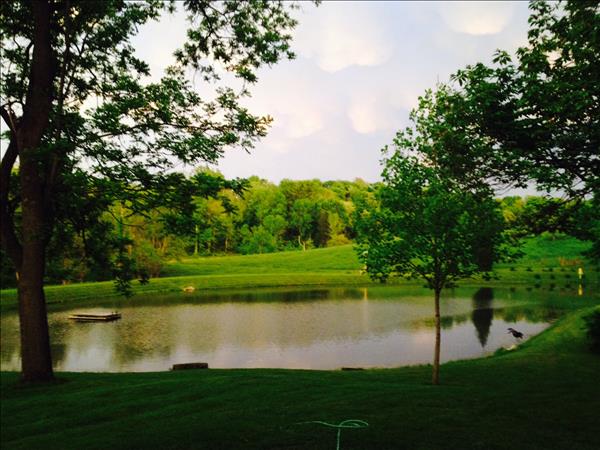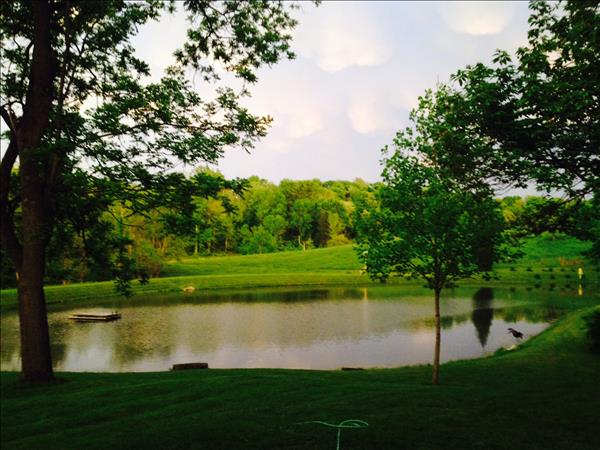
There's nothing like a summer fish fry with fresh fillets of blue gill -- fresh as in pulled from the pond just a few hours earlier. My brother-in-law "The Grub" (seriously that's how he is known in his hometown of Ravenna) is a hell of a fisherman and a real specialist when it comes to catching, filleting and cooking blue gill. Every August The Grub feeds a hundred or so friends with blue gill fillets he has gathered during the course of the summer. He has it down.

PICTURE PRETTY: Our farm pond is a lot of work but it also offers a place to fish and swim and paddle and watch the barn swallows hunt for bugs.
Recently he came to visit our farm to erect a purple martin box he had built next to our one-acre farm pond. That done, there was plenty of time left for fishing. He just happened to have a small container of maggots his favorite bait and his rod with him. Within a few minutes The Grub hooked some 35 nice-sized "brim" to fillet and feed a gathering of friends for dinner. I can tell you he's good with a fillet knife. In less time than it took to catch them, he had them peeled from the bone ready and soaking in ice water. Using his secret blend of Aunt Jemima pancake flour and Shake and Bake seasoning, he had them ready to be fried up. After a couple of minutes in sizzling oil, the fillets were fresh on a platter eagerly being scooped up by guests.
Fishing our farm pond is one thing, but taking a dip on a sweaty summer day is another. I don't do it as often as I used to when we had children ready to wade in at moment's notice, but I still take advantage of the spring-fed water on a regular basis in the summer months. To feel the layers of hot water on top and frigid water below is about as refreshing as it gets in humid summers of Ohio.
All of this comes with some effort. After 30 plus years of keeping a pond looking like the nice clean, weed-free pool my wife expects, I've learned a lot. First of all, cooper-sulfate is a miracle worker for algae. Treating the pond with dissolved crystals a couple of times each summer keeps the floating mats to a minimum and does it without harming the fish and other wildlife in the water. The key is to treat the water early as in February or March depending on the winter. This year there was till ice on the pond in February. So I treated in March.
I used to drag a burlap bag with copper-sulfate crystals in it along the pond's edge. Now I dissolve the crystals in a bucket of water and drizzle the solution along the pond's edge. I wait for a bright sunny day so the algae are actively photosynthesizing. The water along the edge turns a faint blue for an hour or so as the algae takes in the toxic compound.
My second big lesson came from Perry Orndorff, recently retired wildlife specialist with Fairfield Soil and Water District. At a pond clinic a few years ago he introduced me to a large aluminum rake for pond weeds. It has a swimming noodle-like float attached to the blade so it sits on the water. It also has a rope on the end so you can throw it out and pull in the floating algae. Perry called it the best tool you can have for your pond and I thoroughly agree. You can also take the float off and rake out weeds from the pond edge.
Over the years I have had some outbreaks of various other pond weeds -- specifically the long feathery filamentous algae. One year it was so thick we waded into the water and ripped it all by hand. Another brother-in-law "The Flash" (I am not making these names up) loaded it into his dog trailer and took it home to use on his garden in Georgia. He said it made great mulch and improved the red clay soil at the same time.
Now I use spot treatments with diquat herbicide when pond weed gets too thick. A little of along the pond's edge is great cover for aquatic invertebrates and tadpoles or turtles but sometimes it starts to grow into a submerged hedge and needs controlling. Again diquat is not toxic to the freshwater critters, but I still try to limit the applications.
My next move may be to install an aerator in the bottom of the pond. This would even out the layering I enjoy so much while swimming, but it would also prevent pond inversion, which has hit our pond a couple of times. What happens is in late summer a storm can cause the pond layers to flip brining dense bottom water with little oxygen in it to the surface. Fish that are used to coming to the top to fill their gills are suffocated by the dense water now at the upper layer of the pond.
I will never forget coming home on an August afternoon many years ago and finding turkey vultures perched on nearly every fence post that surround our pond. The birds would flop over to the water edge where our biggest bass were floating on the surface. It was a disaster.
Now I watch for signs when the weather is right. Other years I have noticed the fish rising to the surface and appearing to gulp the air for water. I was able to use the garden hose or a small pump to splash the surface with water and re-mix air with the top water enough to provide oxygen to the fish.
If all of this sounds like a lot of work, it is. Add to that periodic weed-whacking around the edge to prevent the cattails from spreading from the wild end of our pond. And of course the reshaping and rebuilding of drain pipe we had to do and it can be expensive too.
None of that stopped me from building a second pond a few years ago to control severe gullying the creek was doing to our pasture. Actually the new pond is my experiment in what happens when you let nature have her way with a body of water. Maybe not completely. While I have tried to keep the maintenance to a minimum, there are still willow saplings to cut off the dam and some cattail control to make sure I can still see where the pond is. And I did add some white Amur or grass carp to eat algae. And I have moved some bass from the old pond. And sink some pine trees for fish cover.
What can I say, the joy of the ponds bring overcomes the problems they present.
About the Author(s)
You May Also Like




